Last night’s rain sits on the tips of the grass, filling the air with a fresh, dewy scent. Birds tweet beneath feathery clouds, while bison roam nearby but out of sight. Uintas — small brown squirrels native to the western United States — scamper across the field, disappearing into the surrounding aspens and sage grass. The Teton Range, snow-covered and sharp, rises at our backs.
Kathryn Mapes Turner ’95 is so fixated on the square of landscape in front of her that she doesn’t seem to notice any of it. Turner is concentrating on her “topic sentence” — what she wants to say with today’s painting. She wears a brown apron dotted with blue and yellow paint over a puffy jacket, keeping the early-morning May chill from shortening her time en plein air.
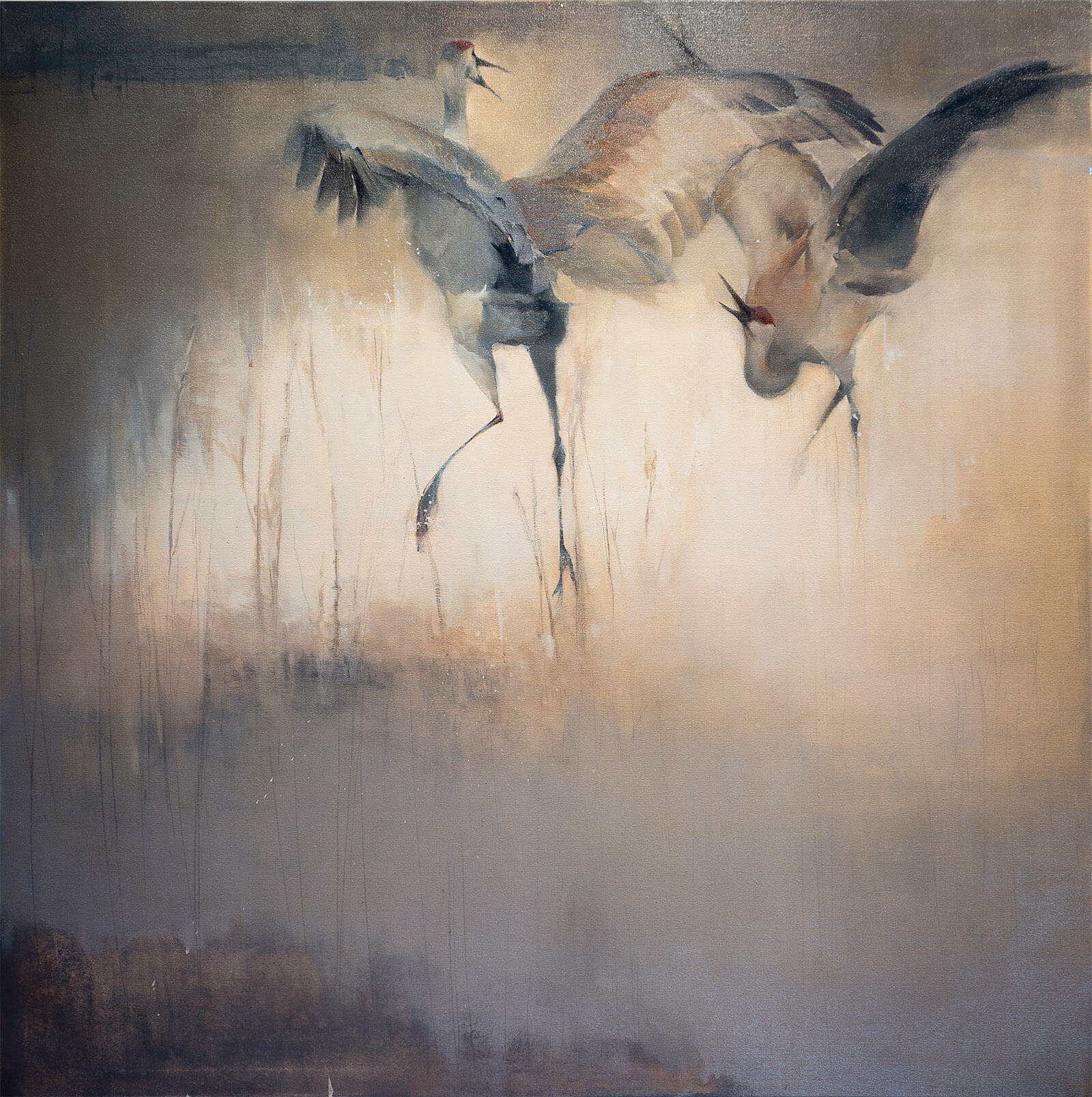 Grassland Dancers (oil on canvas 48” x 48”) by Kathryn Mapes Turner ’95
Grassland Dancers (oil on canvas 48” x 48”) by Kathryn Mapes Turner ’95
After composing a couple of quick sketches in pencil, she turns to her paints. She swirls two shades of brown together with a touch of black, holding up the result every few seconds to check it against the trees she’s replicating. She does the same with the greens. Satisfied with the hues, she positions the wood palette in the crook of her left elbow and begins to add color to her small canvas. With each brushstroke, the aspens and shrubbery come more into focus. Turner approaches her work with the precision of a scientist — single-minded and exacting — but her fingers also move freely, hopping from one edge of the canvas to the other.
The 46-year-old has lived here, in Jackson, Wyoming, almost her entire life. Every detail of this place — a rugged mountain town surrounded by protected national park and forestland — lives in her bones and manifests in her paintings. During our hour or so outside this morning, the light shifts, the clouds rearrange themselves and new shadows appear. Turner relies on her initial topic sentence to guide her as much as she lets muscle memory take over, because even when she is painting what’s right in front of her, she’s also communicating her life story and the story of this isolated place — a saga that began generations before she was born.
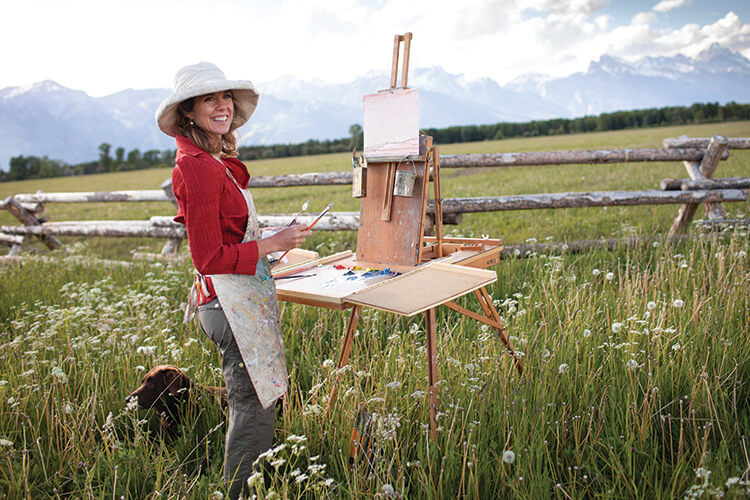 Photo by David Stubbs
Photo by David Stubbs
Down a bumpy, dirty road, about 25 miles from town, Turner turns the wheel of her white Acura to the right and we drive under a wooden entry labeled with Triangle X Ranch’s brand. Green-roofed cabins come into view; horses wander around a pen. We walk into the Main House, empty but for a pool table sitting on an antique rug. The dude ranch isn’t yet open for the season.
Five generations of Turners have called the Jackson Hole valley home. They've lived on this land, in what's now Grand Teton National Park, for more than 90 years.
She walks me over to a sepia-toned photograph hung in a dark, knobby wooden frame. In it, a young woman grins at something in the distance. She’s holding a horse’s reins as it drinks water from what could be a lake or a pond. Her hat is tipped back, away from her face, and she looks at ease in her chaps. “This,” Turner says, “is my grandmother.”
Five generations of Turners have called the Jackson Hole valley home. They’ve lived on this land, in what’s now Grand Teton National Park, for more than 90 years. Today, wannabe cowboys and -girls visit Triangle X Ranch to stay in rustic cabins, ride horses and square dance — and to spot elk and bison wandering the property and the forests beyond. But Turner’s ancestors came here following the promise of the Western frontier.
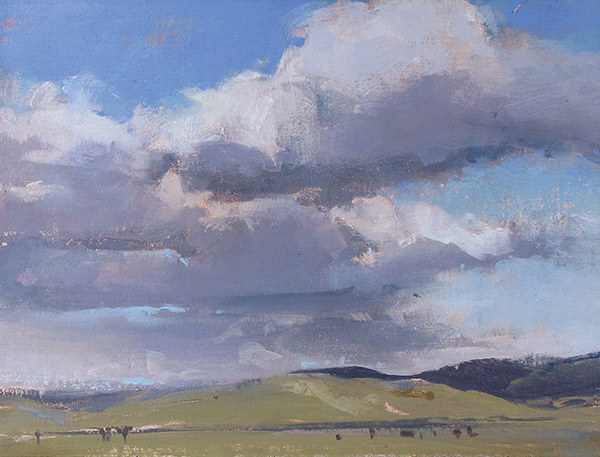 Cumulus (oil on linen 9” x 12”) by Kathryn Mapes Turner ’95
Cumulus (oil on linen 9” x 12”) by Kathryn Mapes Turner ’95
They originally settled near Morgan, Utah, as part of the Mormon migration of the 19th century that delivered tens of thousands of Mormons to what was known as the Utah Territory, and established a cattle ranching operation. In the summers, Turner’s great-grandparents would travel to Jackson Hole to camp and fish along the Snake River, and they’d pass this plot of land in the shadow of the Tetons. Eventually, in 1926, John S. Turner, Kathryn’s great-grandfather, bought the property from a homesteader and moved all of the family’s belongings more than 250 miles via wagon train.
The family home — now known as the Main House, which has since been added on to — was built by hand. It had no electricity or indoor plumbing. A visit to town took four days, round-trip. Turner’s grandmother, Louise Mapes, married the man her dad had hired to take her elk hunting and they had three sons, one of whom is Turner’s father.
Turner’s parents — John ’64, the former director of the U.S. Fish and Wildlife Service, and Mary Kay — had three children. When Kath, as they call her, came along, she was the first girl born into the clan in 60 years. Because of primogeniture, the principle of inheritance in which the eldest son receives the family estate, Turner knew the ranch would never be hers, but she still wanted to show her gratitude for a place that had sheltered and inspired her, and her family, for so long. Instead of working the land, she was going to paint it.
For a town with a population hovering around 10,000 people, Jackson is home to a disproportionate number of exceptional fine artists, and it demonstrates an extraordinary commitment to the arts. There are more than two dozen galleries in the close-knit locale; the Jackson Hole Fall Arts Festival celebrated its 34th anniversary in September; and the renowned National Museum of Wildlife Art — which bought one of Turner’s paintings when she was just 16 — is home to more than 5,000 works, including masterpieces by greats like Georgia O’Keeffe and John James Audubon.
As a kid, Turner wasn’t aware of her hometown’s reputation as an arts enclave. Instead, she was drawn to painting through the bedroom window of her childhood home on the ranch. From that perch, Turner could see the family’s horses roaming around their pen and watch the morning light illuminate the vast landscapes of Grand Teton and of Bridger-Teton National Forest. (Since the homestead is now owned by the federal government, no one in the family lives there anymore. Turner’s brothers still run Triangle X Ranch as an authorized concession of the National Park Service, offering rafting and fishing trips in addition to horseback riding.)
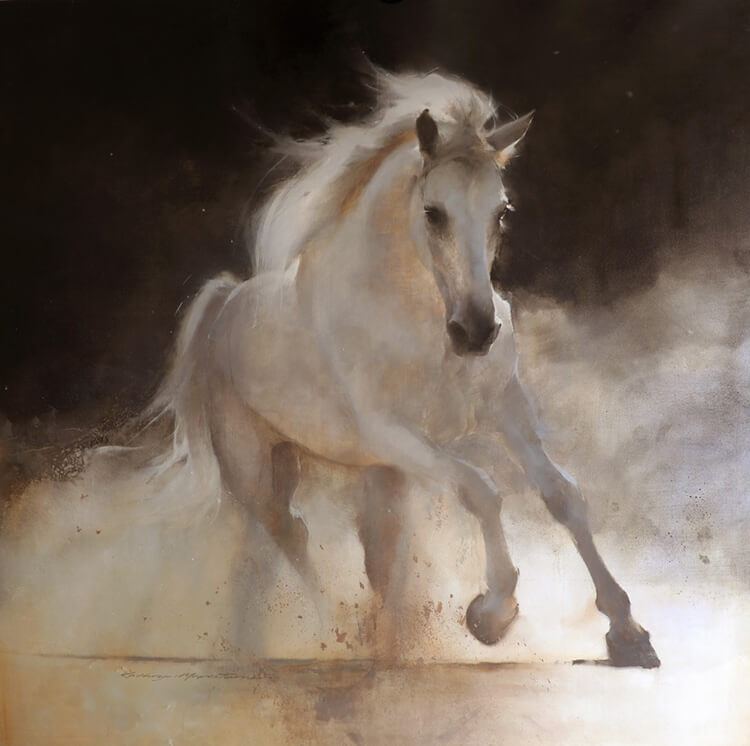 Unbridled (oil on canvas 60" x 60") by Kathryn Mapes Turner '95
Unbridled (oil on canvas 60" x 60") by Kathryn Mapes Turner '95
“The ranch is why I became an artist,” she says. “As long ago as I can have memory, I remember being deeply moved by the beauty I’d see outside my window every day.” Back then, her subject matter was based on “how far I could carry my paint kit comfortably.” She’d toss her gear in her saddle bags, hop on her horse and search for her next topic sentence.
"The ranch is why I became an artist. As long ago as I can have memory, I remember being deeply moved by the beauty I'd see outside my window every day."
Professional artists were drawn to the landscape, too, and many would visit the ranch to work. Turner would scrutinize their work and their processes. During high school, she spent a summer as a workshop assistant for some. One, Ned Jacob, a nationally renowned painter, lent Turner his field setup. She stayed outside later than all of the workshop’s paying attendees, capturing the last specks of daylight. That, she says, was when she found her life’s mission: “I just thought, I’m going to make art. I was answering a call of my heart.”
Her passion was clear, but Turner didn’t know that she could make it a career. She followed in her family’s footsteps and attended Notre Dame to get a liberal arts education. Her father, one brother and a cousin are all alumni, and her parents met there. She signed up for every art class available and traveled to Rome to study art history for a semester, then took a year off to attend the Corcoran School of the Arts & Design in Washington, D.C., before graduating from Notre Dame. Turner then earned a teaching degree from the University of Virginia and took a job as an art teacher in the area. But she was still spending her summers painting at Triangle X. She soon realized that Jackson was where she needed to be. It was time to take a chance on her hobby.
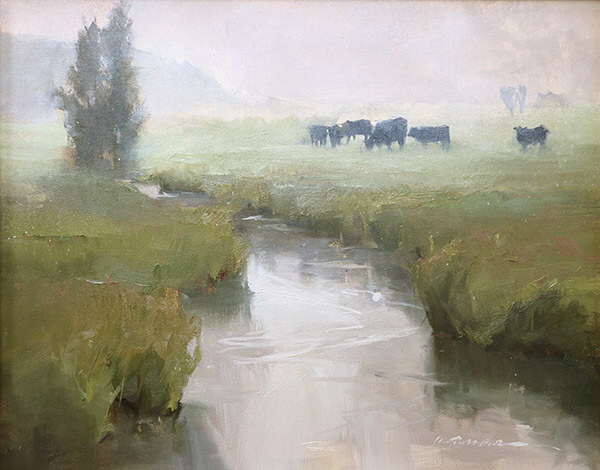 Misty morning on Spring Gulch (oil on canvas 16” x 20”) by Kathryn Mapes Turner ’95
Misty morning on Spring Gulch (oil on canvas 16” x 20”) by Kathryn Mapes Turner ’95
In 2000, she returned to Jackson for good. Her father’s best friend, Nick Rassas ’65 (a celebrated Fighting Irish defensive back), offered her the use of his Wyoming home, which was empty. She walked in the front door to find an easel set up in front of the living room’s picture windows. All of the supplies and paints she could need were piled around. “I didn’t have to worry about making bad paintings and wasting a $5 sheet of paper,” she says, looking back. “He’s why I’m an artist — he gave me the tools.”
The elk stands in a fog of brown. Perhaps it’s the darkness just before dawn or simply a blurring together of the foliage that surrounds him. He cranes his neck to the right, ears pointed, twisting his upper body to look at something. Dark brush marks detail his eye, nose and mouth. The rest of the canvas fades to white.
It’s Saturday morning, and Turner is flipping through the vast collection of work stored in her studio. She’s already been for a run in the rain — “having the rain in your face makes you feel alive” — and covered everything from what it means to be a female artist to her time at Notre Dame to her diverse artistic influences (Chinese brush painting, Italian Renaissance painters, American masters, the Impressionists — the list goes on) over a leisurely breakfast. The air outside is brisk, and Turner is cozy in black sweats and a sweater, with her sandy brown hair pulled back.
She pulls a series of works out of the storage drawers in her studio, which is really the converted second bedroom of her townhome. They all depict an elk. The first is a pencil drawing of the animal in three different positions. In the second, she’s duplicated the rendering with the most promise — the one with the craned neck — in watercolor, concentrating on his proportions and the balance of light and dark. Then she moved on to crafting him with conté on Italian rag paper, and a vision for her painting appeared. Using oils, she captured him in an effortless but dramatic combination of whites and browns, soft but focused, realism meets impressionism. “And that’s how you make a painting,” she concludes, stacking the pieces together, her green eyes glistening.
“You can tell, if you watch Kathryn work, that she’s having fun doing it,” says Jim Bortz, a fellow wildlife painter and friend. That joy is evident from the moment you meet Turner, but her quick smile belies the hard work behind every piece she creates. The artist spends hours studying wildlife, like the thousands of elk who pass by her house during their annual migration, capturing them in photographs, field studies and quick sketches. She scrutinizes their proportions and how light reflects off their coats as they move. She even has a horse skull in her garage that she analyzes to learn the animal’s structure and dimensions so that it looks as realistic as possible when she paints them. “Everything is anatomically correct. She is intentional. It comes from this very grounded, educated, informed [place],” says Natalie Henderson, art curator for the Southeastern Wildlife Exposition (SEWE), an annual, juried showcase of 100 of the best wildlife and nature artists in the world. “There’s this deep beauty that comes through everything that she does. Everything that Kathryn paints, she lives. Every piece she paints, there’s a real story. It’s not just an empty love of nature. It’s a little piece of her.”
 Rain on still water (oil on linen 12” x 48”) by Kathryn Turner Mapes ’95
Rain on still water (oil on linen 12” x 48”) by Kathryn Turner Mapes ’95
Turner says she doesn’t want her art to read as western or impressionist, or to be known as a female western painter. Her forté is Kathryn Mapes Turner. “I think my subject matter is western. I don’t think all of my influences have been western,” she says. “I try and retain my own voice. I paint what I know, who I am. I don’t give it a ‘western voice.’ I just happen to be a western girl with a Wyoming life.”
Her distinctive style has earned Turner a lot of fans. In February, she was the featured artist at SEWE, a coveted designation. “There has never been a featured artist that has been more celebrated than Kathryn,” Henderson says. “It wasn’t just her work — it was Kathryn. She was a true light in the show.” Her work has been included in the prestigious Birds in Art exhibition at the Leigh Yawkey Woodson Art Museum four times. She has also received an Award of Excellence and Best of Show from the American Impressionist Society and been named Wyoming Artist of the Year.
This past spring, she relaunched Trio Fine Art, a 13-year-old Jackson gallery she founded with two other artists, as Turner Fine Art. “Kathryn needs to be three people,” jokes Barbara Strehler, gallery director. “She has this belief that if everybody does what they like to do and what they’re good at, then from there everything will kind of build. She’s got this great light inside of her that just shines out and takes over.”
Back in that field outside of town, Turner isn’t happy with how her six-by-eight-inch study is looking. She’s detailing the tree trunks with minute, hesitant strokes — not the smooth, confident ones she began with. She hovers with her hand over the canvas. “If I feel like I need to add one more thing, then it’s already overpainted.” She decides the piece is done. Two minutes later, she fills in the trunks a bit and makes other adjustments. I can see the wheels turning as she squints at the canvas, trying to work out what it is that feels off. Another few minutes and another few flicks of the wrist later, she steps back. “I like it now.”
 Crossing (oil on canvas 60” x 48”) by Kathryn Mapes Turner ’95
Crossing (oil on canvas 60” x 48”) by Kathryn Mapes Turner ’95
Turner has dozens of studies like this one. Some become the foundation for larger paintings. Others are stored away — practice pieces that taught her something about style or form or process. “I aspire to make something great, but that’s not what it’s about,” she says as she cleans her brushes one by one. “Sometimes magic happens. The really important thing is just to enjoy the process.” It’s the kind of logical but irritating advice mothers like to propound. But Turner is so pure in her affection for art and for this land that her comment doesn’t sound trite at all. It’s sincere and simple advice. Turner truly does enjoy the process: the hours outside fighting against the wind and bugs to capture a scene just so; sketching the various bones and musculature of a horse over and over to learn what’s beneath the hair; the boring emails and administrative chores that running a gallery requires. Each task is necessary for her to make art, and making art is all she’s ever wanted to do.
Even if Turner goes home and realizes that today’s piece isn’t quite telling the story she wanted to tell, she’ll be satisfied because she spent the morning playing outside, looking at the same hills that called her family to this valley all those years ago. That’s just about the best way anyone can spend a day, she’ll say. Besides, there’s always tomorrow.
Daliah Singer is a freelance journalist based in Denver.
